Metaverse 101: A Primer and Early Trends

Introduction
What is the metaverse, and how does it work? Googling this straightforward question yields a plethora of responses. The objective of this primer is to present the metaverse in the most basic terms possible.
The key differentiator and area of improvement that the metaverse offers in comparison to desktop/mobile is context. The metaverse places users inside of a virtual rendition of the internet, which increases the fidelity of that user's experience by many orders of magnitude (think 100x or more). The internet's context today essentially amounts to a very souped-up, dynamic version of a piece of paper. In fact, HTML web pages are still technically referred to as documents by developers, and modern front-end web development frameworks are predicated on the manipulation of various HTML document elements in a manner that delights users. If the internet boils down to dynamic pieces of paper we browse, the metaverse boils down to dynamic 3d worlds we get to explore. This is an important concept to note because humans are explorers at heart. The metaverse will be able to tap into our natural bias towards physical exploration better than any version of the internet today ever will. If you’re curious about a concrete example that underscores this key point, read about how world-record memory champions leverage memory palaces to store an inordinate amount of information in their brain. In a similar way, the virtual-but-physical-seeming nature of the metaverse can be a step function improvement over the decidedly flat internet we know today.
As promising as this massive contextual improvement is, metaverse development has a long way to go. While early iterations of the metaverse show compelling results, there are still several advancements that must be made before the metaverse will be able to support mainstream levels of adoption. These advancements will take longer than what we’ve seen with the rise of smartphones, as the underlying technology is more complex and requires more robust infrastructure than what is available today.
This primer will examine the concept of the Metaverse from three distinct angles: Background & History (how we got here), Gaming & Web3 (where we stand today), and Foundational Pillars (where we are going).
Background & History
The metaverse can be best thought of as a trend. Specifically, the metaverse is a trend that will ultimately play out as the natural successor to the mobile internet. The metaverse is the next logical step in society’s digital evolution. The metaverse will not entirely replace mobile; rather, it will complement mobile and gradually occupy an increasing amount of our time. By examining the history of the mobile internet, we can better understand how the metaverse may unfold over the next decade.
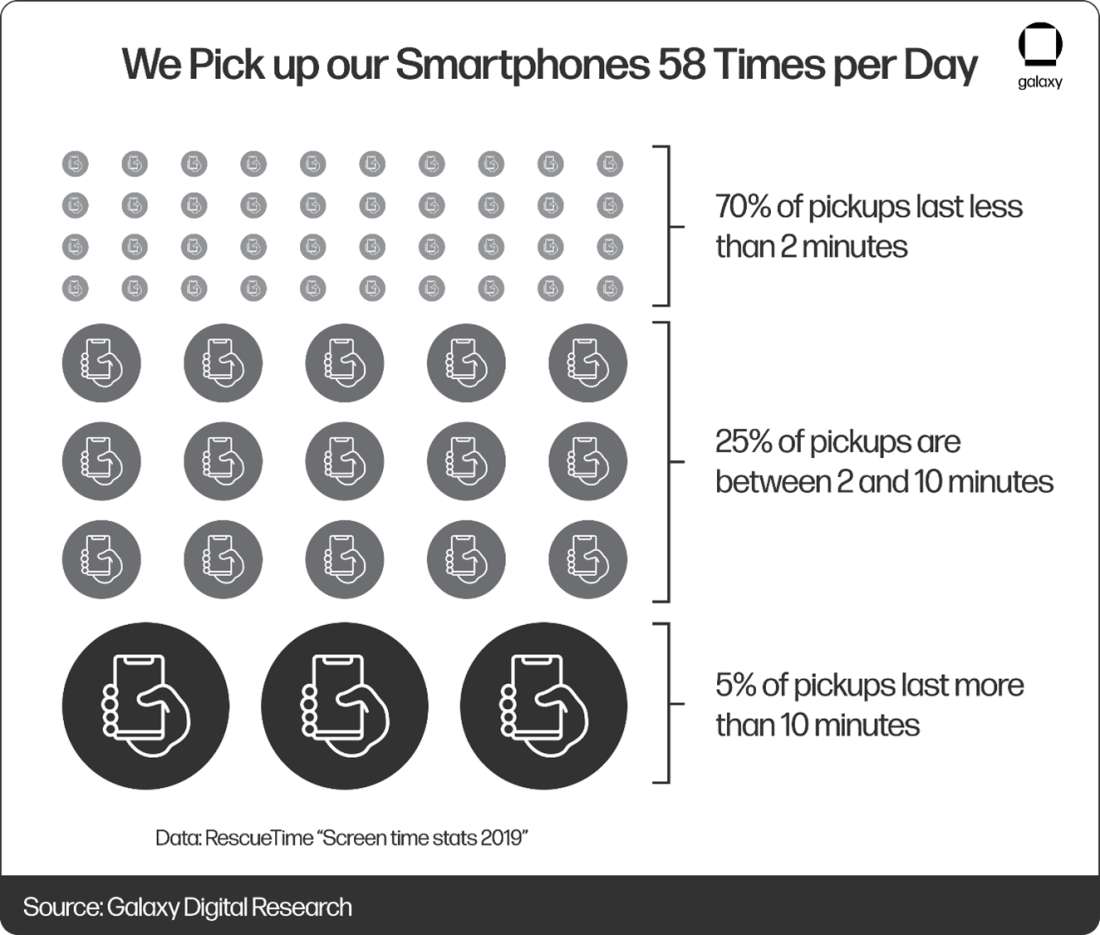
We will start this primer by examining data that clearly shows how the mobile internet took over our day-to-day existence gradually, then suddenly. Smartphone sales, for instance, picked up steam a few years after the introduction of the iPhone in 2007. The inflection points for smartphone sales occurred in 2011 and 2012, which, coincidentally, is when Apple broadened its distribution to carriers outside of AT&T (Verizon sales started in February 2011). Sales then exploded, peaking in 2018, before leveling off. Today, smartphones are a mature technology with only iterative improvements between device generations. This might explain why consumers are holding onto smartphones longer, based on data from Kantar Worldpanel. Considering this trend, the business models for mobile phone manufacturers has shifted away from hardware sales over to SaaS.

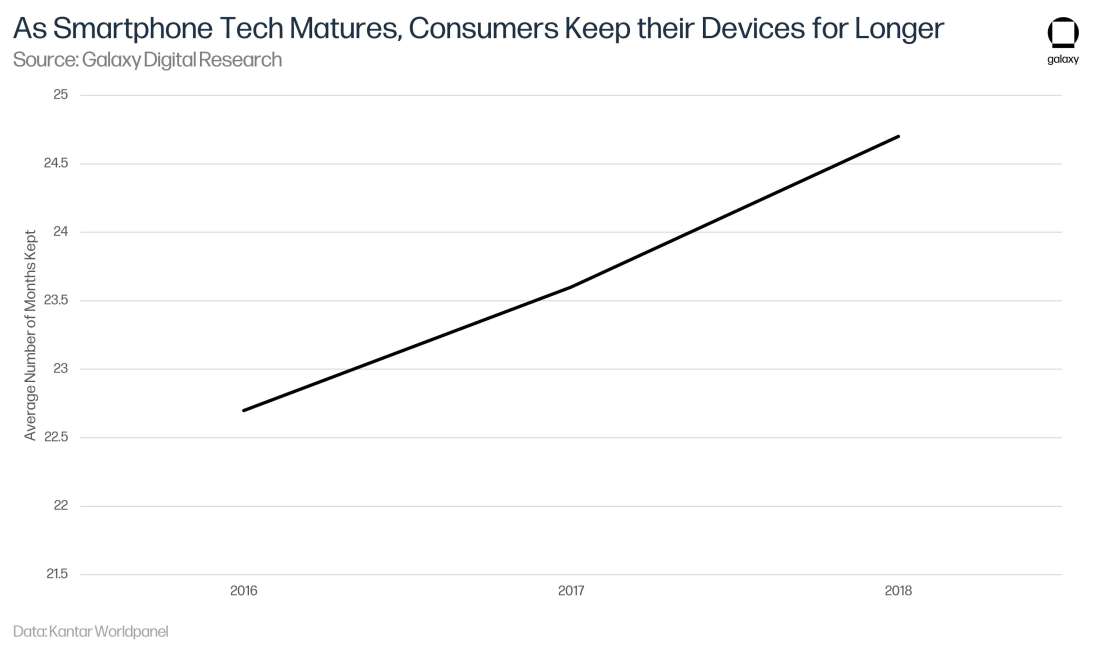
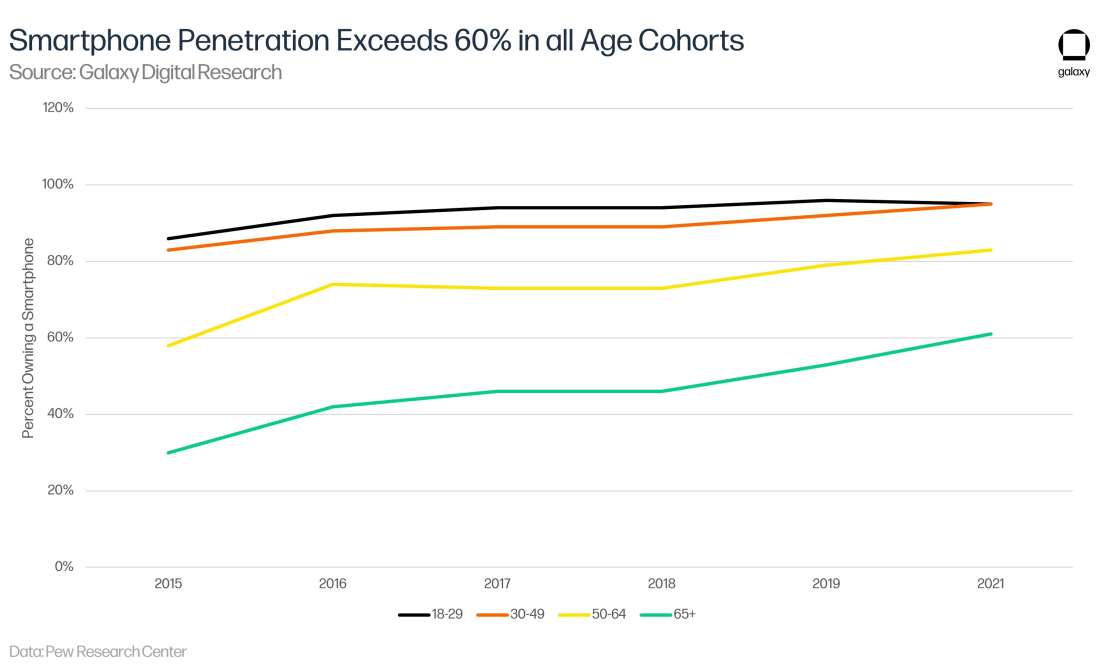
However, smartphone sales only explain part of this story. It is equally important to examine user behaviors enabled by the prevalence of smartphones. One interesting metric to study is how smartphones overtook television as the preferred medium for leisure time. From 2014 to 2021, mobile occupied an increasing percentage of their users' time, on average, compared to television —flipping television altogether in 2018. Keen entrepreneurs started to migrate marketing dollars away from television advertising towards mobile advertising due to this trend. It is no coincidence that many direct-to-consumer (d2c) brands born in the 2010s were the most adept at mobile advertising, and some even rode this consumer behavior shift to billion-dollar valuations (see Allbirds, Away, Dollar Shave Club, Warby Parker, etc). On the other hand, companies that were slow to adopt this trend struggled.
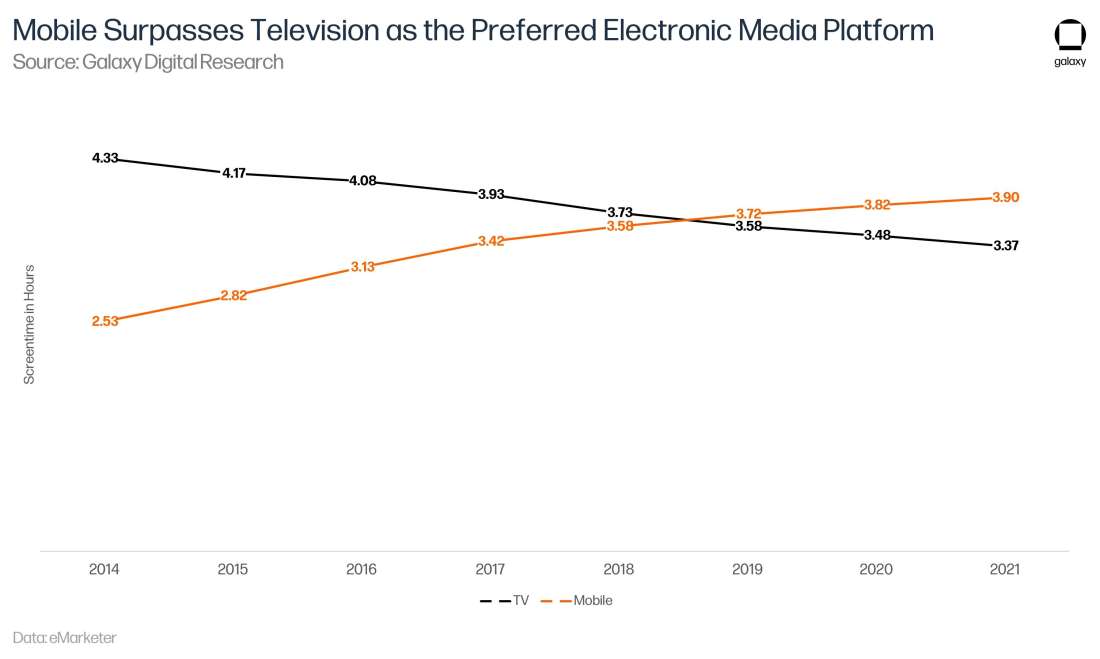
Walmart is an interesting case of a company that initially struggled with consumers’ move to mobile, but was then able to adapt. In 2015, Walmart made the strategic decision to double down on eCommerce after its first revenue decline since 1970. The company purchased several of eCommerce companies, including Jet.com for $3 billion (in 2016), Bonobos for $310 million (in 2017), Eloquii for $100 million (in 2018) and ModCloth for between $50 million to $75 million (in 2017). Today, Walmart occupies the #2 spot for top eCommerce retailers in the U.S., trailing only Amazon (Walmart market share is 6.6% compared to 41% for Amazon according to Statista). Walmart is now aggressively pursuing a metaverse strategy, perhaps having learned a lesson from their slow entrance into eCommerce. Regardless of how rudimentary their efforts towards cultivating a VR shopping experience are today, their efforts are no coincidence. Other companies seem to be following suit, which may explain the explosion of corporate interest in the metaverse (measured by metaverse trademark filings). The rapid growth of corporate metaverse interest is happening despite how early we are in the metaverse's adoption cycle.
Outside of eCommerce, the attention economy dominates the strategy underpinning mobile-first tech juggernauts like Meta (formerly Facebook). These days, the primary method for maintaining mobile application engagement is leveraging recommender systems. Recommender systems are machine learning algorithms that customize feeds of data (such social media posts, videos, blogs, products, etc.) to the specific tastes of the user. The mechanics of how these algorithms work is outside the scope of this primer, but they boil down to finding new content to recommend to the user that 1.) is watched by other users who are most similar to the user in question and 2.) is engaged with the most by similar users (as measured by product sales, time spent watching videos, clicks, etc.). The reality is that the recommender systems used by industry giants are incredibly complex and employ various methodologies that shouldn’t be oversimplified. However, this innovation has resulted in even more leisure time being spent on mobile devices than what was previously considered possible (in other words, what was previously achievable with reverse-chronological feeds employed by early versions of Facebook and Twitter). Two applications that are perhaps the most notorious for being at the cutting-edge of recommender system development, by virtue of integrating them most deeply into the core of their product offerings, are YouTube and TikTok.
The rise of TikTok should have been apparent for a while, as kids are often leading indicators of technological advancement, and Tik Tok’s earliest adopters were younger users. What was once considered a niche social media app for recording lip-synced dances just a couple of years ago catapulted to the very top of the App Store in April 2022. According to a study conducted by Qustodio, today, users in the US aged 4- 18 years old spent, on average, 100 minutes per day on TikTok. While the implications of this time being dictated by a China-based corporation raise some separate concerns, the key takeaway for the purposes of this primer is that we spend most of our free time bouncing around between various mobile applications. Mobile applications are the primary context through which consumers interface with the internet. We expect the metaverse to flip mobile for consumer engagement over time, and this may be further amplified by the continued advancement of ML algorithms such as recommender systems. The economic value of this attention, particularly from younger users, cannot be understated, and this underscores why the metaverse is such an important societal shift to continually monitor.
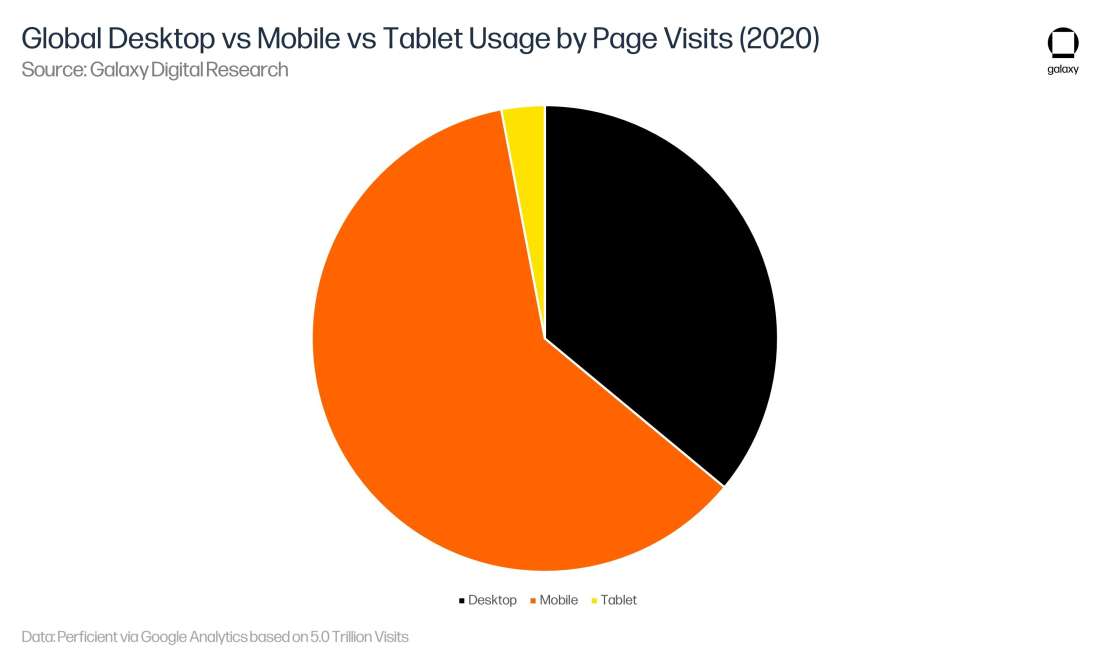
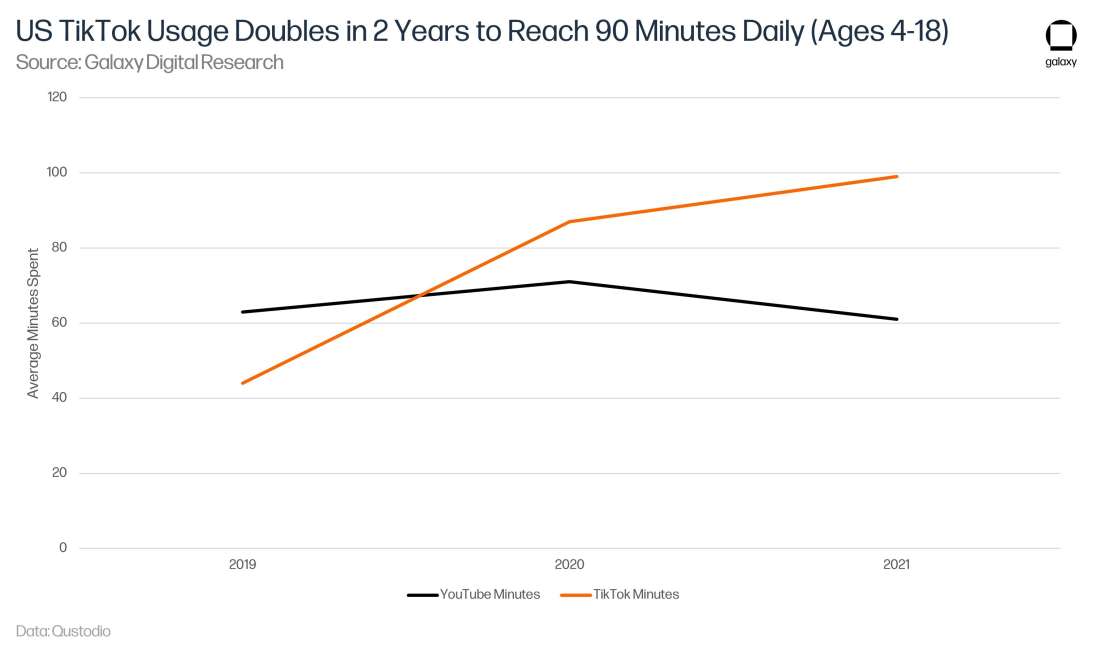
COVID-19 has been a major catalyst for the increased digitization of our lives, both in terms of how we work and how we spend our leisure time, the pandemic revealed that consumers are very comfortable with living and working remotely though a suite of internet-based applications. One study conducted by eMarketer found that COVID doubled the percentage of users under 18 years old who spent 4 or more hours per day looking at screens (defined as smartphone and tablet use). We believe the metaverse will not only occupy our daily screentime in a manner like what we’ve already witnessed with the rise of mobile, but that usage will exceed the screentime of mobile. This is because the metaverse offers a substantial improvement in engagement over the mediums that preceded it.
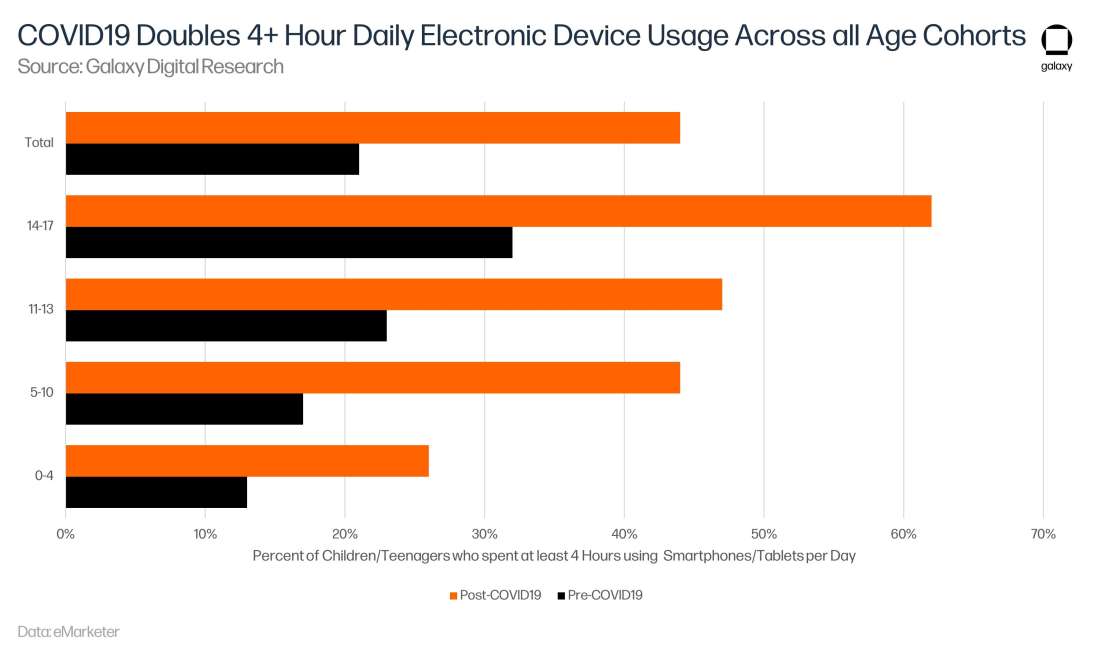
Peeking into the Metaverse through the lens of Web3 and Gaming
Thus far, we have analogized the metaverse with society’s shift towards mobile-centric digital lives. This is because the metaverse is primarily a trend, rather than a specific space, item, or even concrete formulation. Specifically, the metaverse is a gradual trend towards people spending increasing amounts of screentime inside of virtual worlds. Ultimately, this trend will result in most of society’s collective screentime being spent inside of metaverse applications, echoing the eventual dominance of mobile internet applications for our collective screentime today. However, this trend has barely started today. Most people are not using metaverse applications and most are not spending time inside of AR, VR, and/or browser-based virtual worlds. The metaverse only partially exists today, and it exists primarily in the gaming and web3 industries. By examining these industries, one can begin to understand what metaverse applications will eventually look like once they hit mass adoption in the next decade or so.
Below, we provide a more formal definition of what a true metaverse application looks like. Today, there are no existing applications which satisfy all these conditions, but that will change over time.
A true metaverse application should be:
Real-time: Avatar locomotion, voice chat, and text chat happen instantaneously in response to user input. Users can interact with others and both be seen and feel heard.
Always-on (persistent): There’s no concept of scheduling a hangout, one can simply hop in and out of the application much like a bar, coffee shop, or open-world game.
Highly scalable (no noticeable upper-bounds on concurrent users): For a compelling experience, a metaverse application should be able to handle many users simultaneously. A crude benchmark would be the ability to handle the same number of people as a crowded music festival (100,000+). This key hurdle is what will give users the irreplaceable feeling of being in a massive crowd while preserving a sense of individual presence (imagine reliving your favorite concert). The current cutting-edge is Improbable’s M2 technology powering metaverse applications like Yuga Labs’ Otherside (which recently tested at 4,300 concurrent users). (For context, Epic Games’ Fortnite can only support 100 concurrent users today).
Compatible with crypto/web3 economies (self-sovereign items, value): Crypto/web3 powers the economic engine of the metaverse and allows disparate applications and users to transact value between each other. Users can both transact with one another directly or with open crypto/web3 protocols. Existing protocols, projects, and communities across the NFT and DeFi space will be crucial primitives that metaverse developers and users will leverage. (Read our NFT x DeFi piece for insights into what some of these applications look like today).
Permissionless and open (anyone can contribute): Much like the use of the internet, the use of the metaverse does not require the permission of gatekeepers. Any user can both enter the metaverse (read) and create applications for others to use (write). Creators should be able to benefit from the economic value accrual of their creations unencumbered to corporate owners of metaverse infrastructure.
Accessible by the mainstream (open, available): The hardware required to access the metaverse (whether its AR glasses, VR headsets, or mobile/desktop computers) can be accessed at a price-point affordable to a mainstream consumer. Given that metaverse applications are graphics-heavy, this would mean that GPU costs need to come down coupled with substantial increases in performance (this should be achievable based on Moore’s Law).
While no existing applications satisfy all the above conditions, gaming and web3 come the closest. Metaverse applications in the gaming industry can be traced as far back as the early 2000s. These experiments start with games like Second Life and Playstation Home both of which offered real-time and persistent virtual worlds with no objective other than serving as a digital commons for users. The popularity of these games, however, never reached impressive numbers and the experience was relatively bare-bones. In the early 2000s, Massively Multiplayer Online Roleplaying Games (MMORPGs), such as Warcraft and Runescape, became a very popular trend in gaming that pushed the boundaries of concurrent users while cultivating their own, internal digital economies. As impressive as these digital economies centered on in-game items were, they were still sandboxed to the game. At their peak, these games at times supported hundreds of thousands of simultaneous users, thought these users were sharded across hundreds of worlds (not playing concurrently). MMORPGs never quite hit mainstream adoption and remained a niche category of gaming during that era (though a relatively large niche).
The next major wave in gaming started with Fortnite and its Battle Royale format. Fortnite can be best thought of as the first truly mainstream game to naturally morph into a digital commons for people to hang out with each other and chat, outside of simply playing the game itself. Fortnite was also the first major mainstream game to exist truly cross-platform (users could play against and chat with others regardless of their gaming console or operating system). This ultimately pushed major console manufacturers like Sony to break down their online walled gardens and support multiplayer gaming in a cross-platform manner, allowing other games to follow. However, the key differentiator with Fortnite was that the game was completely free-to-play, and the only thing players could buy were character skins which offered zero in-game benefits. In other words, these skins were completely cosmetic and used for signaling status in the game. At its peak in 2018, Fornite was generating $318m revenue per month purely from sales in in-game assets with no utility in the game itself. Based on Fortnite’s success and unique business model, it’s easy to see how crypto/web3 metaverses can build on this success with more in-game items powered by NFTs, which offer a similar issuance and revenue model but with significant enhancements for player experience.
Web3 metaverse applications, such as Decentraland, The Sandbox, and Otherside, aim to augment two decades of gaming development with open economies powered by crypto and web3. Plots of land in these metaverses are NFTs that can be bought and sold on open marketplaces. Currencies within these metaverses, such as $APE coin, can be used with DeFi protocols completely outside of the metaverse application. Identities can be tied to web3 wallets and be repurposed elsewhere. However, in all three of these early web3 metaverse examples, there are still issues of application performance and scalability. While Otherside is currently leading the pack thanks to Improbable’s M2 tech, it still has a way to go before it can be considered mainstream-ready. While web3 continues to push towards building true metaverse experiences for users, no web3 application has yet satisfied all the necessary preconditions identified above to be a fully-realized the vision of the metaverse.
There are many lessons to be learned from the gaming and web3 industries in terms of metaverse development. A future installment of this series will focus exclusively on metaverse innovations within gaming and web3. For this primer, the key takeaway is that gaming and web3 offer the closest insight into what metaverse applications may look like in the future, but they cannot be considered complete metaverse experiences without additional innovations on the broader metaverse stack. It is also unclear if crypto-native web3 projects, like Decentraland or The Sandbox, will be the first to create mainstream metaverse applications or if established gaming companies, like Epic Games (creators of Fortnite), will augment their existing IP with crypto and web3 functionality (indeed, it is likely that both happen). It is clear, however, that there are many moving parts required create a compelling metaverse experience. The final section of this primer outlines these moving parts into a clear taxonomy.
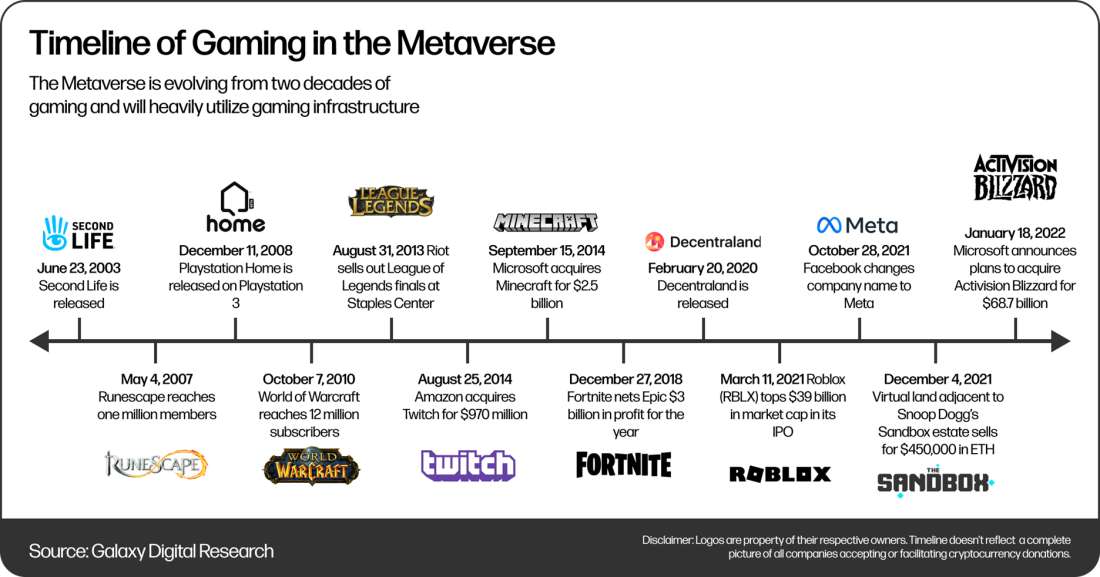
The Foundational Pillars of the Metaverse
While there are many components that will ultimately contribute to the metaverse stack, we believe four key categories will be the most important in the near-term: Infrastructure, Hardware, Applications, and Crypto/Web3.
The following section defines each of these four categories briefly and offers some examples of what they look like today. Future iterations of our Metaverse series will dive into these various components of the metaverse stack in more detail.
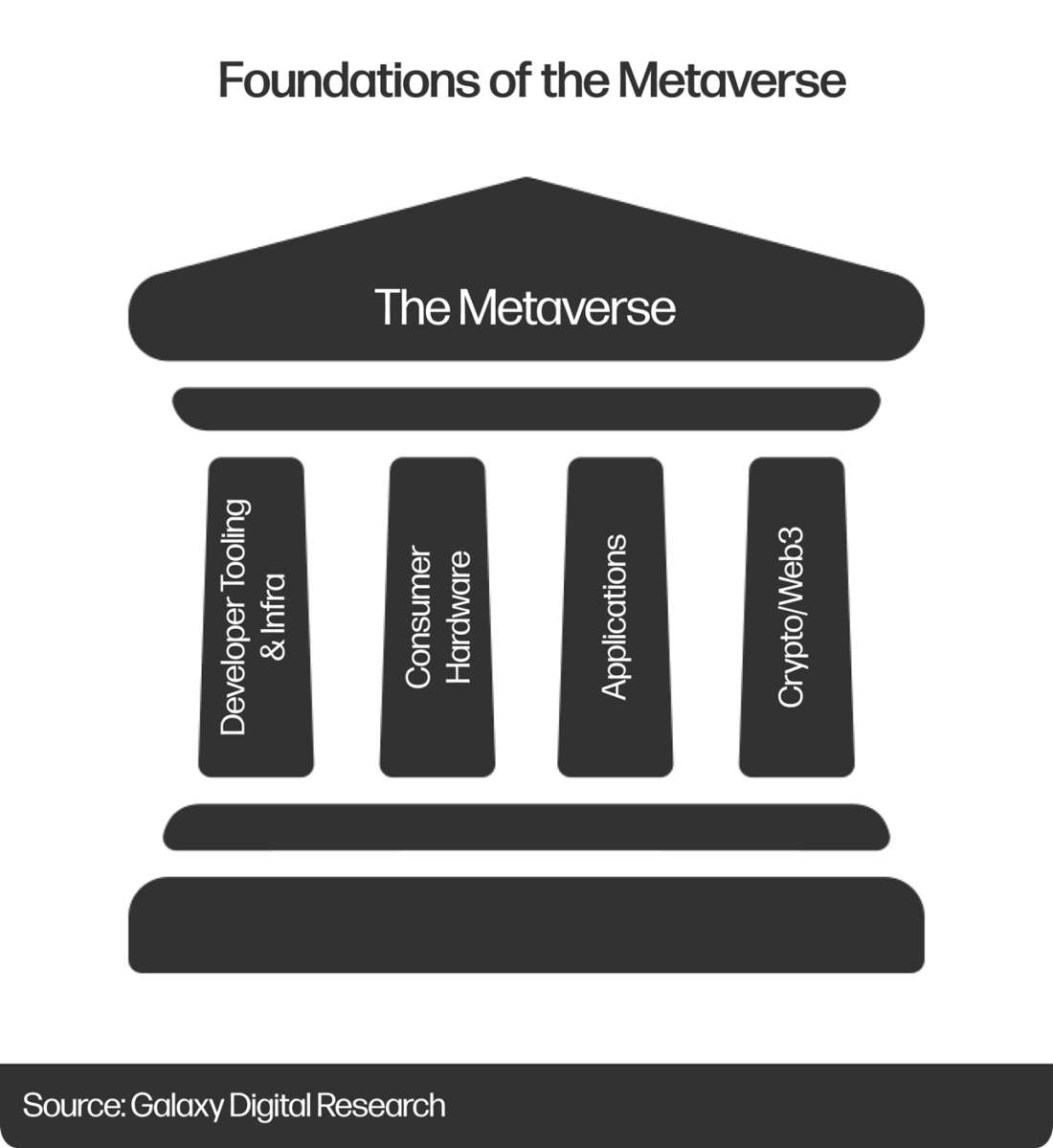
Infrastructure
Infrastructure refers to tools, protocols, and standards that developers will need require to build convincing and interactive metaverse experiences for end-users. Game engines, powered by the likes of Unity, Unreal, and Improbable fall into this category. Standards like WebXR and WebGPU are also grouped here. Broadband providers and networking infrastructure also fall into this category.
Key activities enabled by infrastructure:
Persistently connecting many users in real-time
Performing in-game physics calculations
3d model rendering
Virtual world creation
Decentralized data packet transmission
Interoperable standards for rendering virtual worlds
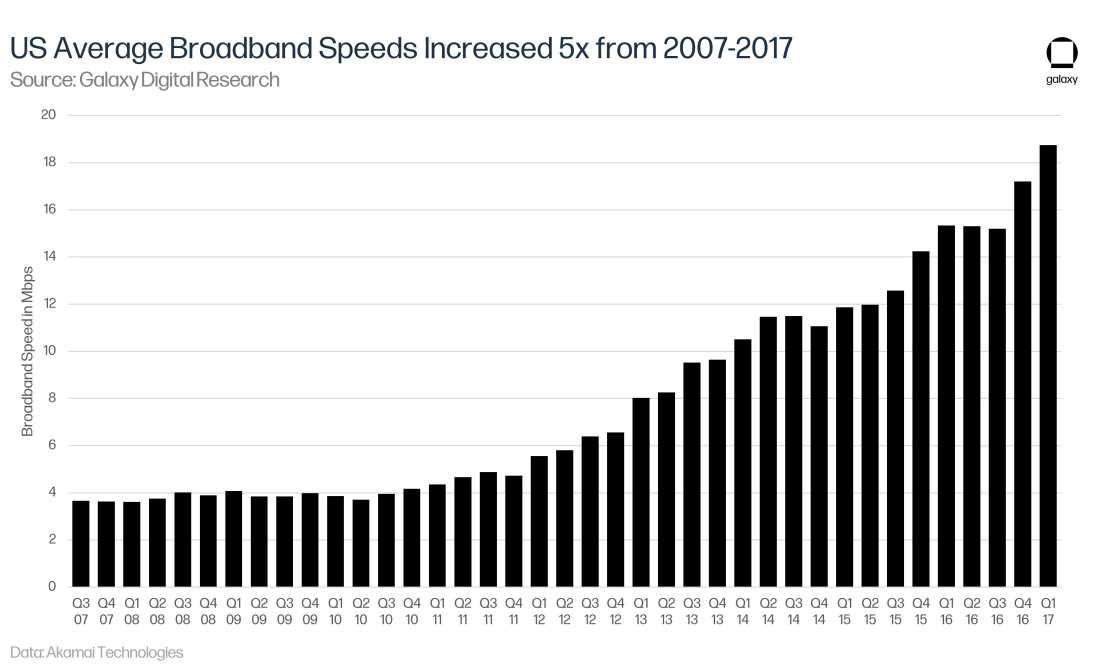
Broadband speeds must continue advancing to power these high throughput metaverse applications. Building a metaverse application in the absence of ubiquitous, high-speed internet would be the equivalent of attempting to build Netflix in 1994.
Hardware
Hardware refers to both consumer and enterprise hardware. In terms of consumer hardware, this includes, but is not limited to, VR headsets, AR glasses, smartphones, desktop computers, wearable input/output devices, brain-computer interfaces. On the enterprise side, we mainly refer to tools used to accurately track and portray people in metaverses for enterprise-oriented applications (think Zoom on steroids). This includes sensors and systems for tracking movement, cameras with wide-angle and/or fast lens, stabilized video capture devices, directional, studio-grade microphones, studio-grade lighting. Over time, we imagine these two verticals will both advance and converge with considerable overlap as costs come down and demand goes up. We also imagine new product categories focused on metaverse use-cases to emerge. Historically, one example that illustrates this trend is how digital video cameras existed in the 90s, but webcams weren’t popular until the 2000s. Both are fundamentally cameras, but they occupy completely different segments and SKUs (stock keeping units) within their respective markets today.
Key activities enabled by hardware:
Transmitting the UI/UX for metaverse applications (similar to mobile phones today)
Tracking physical movement of the body for locomotion within the metaverse
Capturing and relaying speech
Capturing and relaying facial expressions
Broadcasting users into metaverse applications at high-fidelity
Broadcasting augmented reality experiences into the physical world
Handling heavy, graphics-based computation associated with metaverse applications
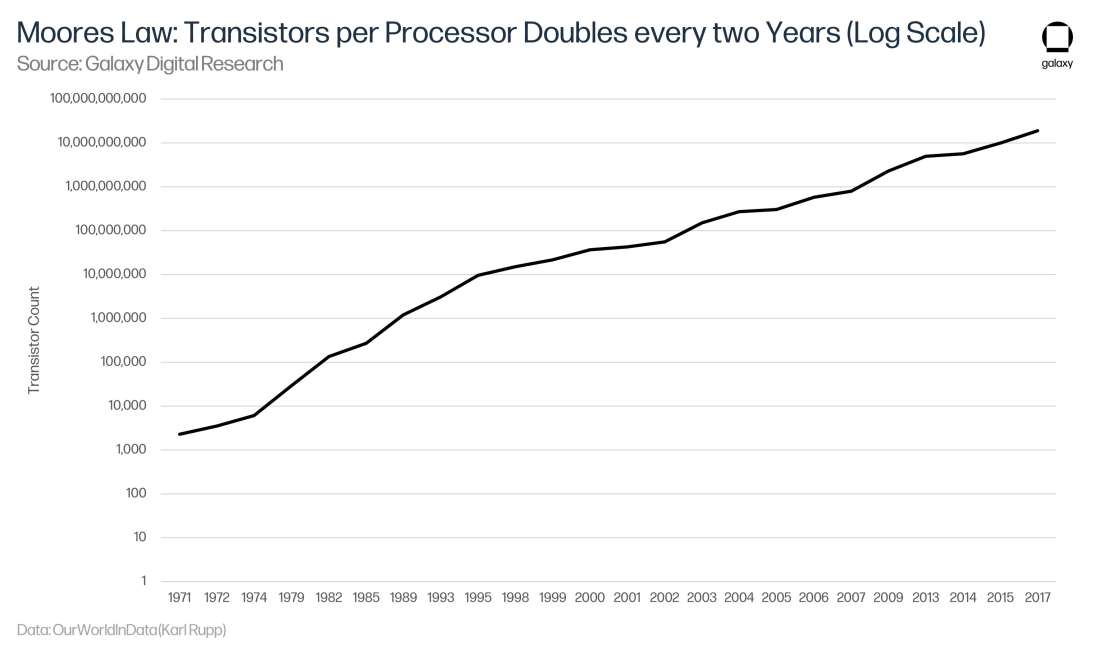
Moore’s Law has been the trend to watch in hardware over the past 40 years, and we expect the trend will continue to be relevant in the future. More importantly, Moore’s Law, as it pertains to graphics computation, will be increasingly important as metaverse applications tend to be very graphics-heavy.
Applications
Applications are the software layer of the metaverse. They will leverage and be built for existing infrastructure and hardware to cultivate unique experiences and metaverse worlds. There will be many metaverses just as there are many applications and games users play today. Initially, many applications will be focused on games as gaming will be the “trojan horse” use-case driving initial metaverse adoption. Understanding the gaming industry is crucial to understanding how applications in the metaverse will evolve. In a future installment, we will be diving into the history of gaming and how it can be studied for a better understanding of what the metaverse will evolve into. With that said, other novel use-cases, completely unrelated to gaming, will also emerge.
Key activities enabled by applications:
Housing the software layer of the metaverse
Attracting the mindshare of developers towards standardized app protocols
Gaming
Visual entertainment (movies, sports, new forms of art)
Audio entertainment (music, virtual concerts, soundscapes)
Working remotely in a virtual office
Shopping in the metaverse
Meeting and interacting with new people
Socializing with existing friends in a persistent, non-objective-oriented setting
Crypto/Web3
We spent the entirety of this primer without once mentioning cryptocurrencies, NFTs, or the blockchain. This was not by accident. The metaverse is a massive trend that encompasses many pieces of technologies and protocols outside of the crypto space. However, we believe crypto will be economic engine that both powers economic activity on the metaverse while serving as a common thread between distinct metaverse applications, allowing them to interface with one-another. We envision web3 wallets serving as an identity layer, holding both NFTs and fungible tokens in a permissionless, interoperable manner. Metaverse applications will be able to seamlessly integrate cryptocurrencies and NFTs for a variety of novel use-cases. Crypto will ensure that the metaverse is both open and permissionless, and will enable creators and developers to prosper from the massive economic opportunities unlocked by the metaverse. To the extent crypto is integrated into various metaverse experience as a core component, the metaverse in totality will be more valuable to beneficial for society.
Key activities enabled by crypto/web3:
Logging into metaverse applications (connect wallet)
Serving as an identity layer for metaverse applications (through wallets and associated NFTs and fungible tokens stored in those wallets)
Powering the economic engine of the metaverse, allowing users to transact value both directly (peer-to-peer) and through DeFi applications
Token-gating sections of the metaverse (requiring fungible tokens and/or NFTs for access)
Storing value in the metaverse (virtual land plots, crypto assets related to various metaverse applications, etc)
Rewarding users directly for behaviors and actions taken within metaverse applications (future of consumer loyalty programs)
Cultivating communities within the metaverse (as seen with the prevalence of NFT communities today
Conclusion & Outlook
While metaverse development and adoption is still in its early stages, we believe that it has the potential to be one of the largest disruptive forces in society over the next decade. Crypto and web3 will be an extremely important primitive for the metaverse to leverage going forward. Future installments to this series will dive into various sub-components of the metaverse, with a particular emphasis on where crypto fits into the broader narrative.
Key-Takeaways:
The metaverse is not a single virtual world, application, piece of hardware, or experience. The metaverse is an amalgamation of all the underlying primitives outlined in this primer, and its closest existing analogue is the entirety of the internet
The metaverse boils down to a societal trend that will be the successor to the mobile internet
People already spend a lot of time on mobile devices today, and they will spend even more time inside of metaverse applications once the underlying infrastructure mature
Understanding the evolution of mobile will help one predict how to metaverse may play out over time
The metaverse will offer orders-of-magnitude more fidelity than existing internet applications
Humans will resonate with metaverse applications at a deeper level due to our biological underpinnings as explorers vs purely visual consumers
A true metaverse experience must satisfy all of the following conditions: real-time, always-on, highly scalable, crypto-enabled, permissionless and open, and accessible by the mainstream
The Gaming and Web3 spaces offer the closest working examples of metaverse applications today, but they fall short of being true metaverse experience
The key foundational pillars of the metaverse include infrastructure, hardware, applications, and crypto
The metaverse isn’t ready for mainstream adoption yet, many ancillary protocols, standards and technological breakthroughs need to be created first
Crypto will power the economic engine of the metaverse
Crypto will ensure the metaverse is open, permissionless, and the most value-accretive to society
Legal Disclosure:
This document, and the information contained herein, has been provided to you by Galaxy Digital Holdings LP and its affiliates (“Galaxy Digital”) solely for informational purposes. This document may not be reproduced or redistributed in whole or in part, in any format, without the express written approval of Galaxy Digital. Neither the information, nor any opinion contained in this document, constitutes an offer to buy or sell, or a solicitation of an offer to buy or sell, any advisory services, securities, futures, options or other financial instruments or to participate in any advisory services or trading strategy. Nothing contained in this document constitutes investment, legal or tax advice or is an endorsement of any of the stablecoins mentioned herein. You should make your own investigations and evaluations of the information herein. Any decisions based on information contained in this document are the sole responsibility of the reader. Certain statements in this document reflect Galaxy Digital’s views, estimates, opinions or predictions (which may be based on proprietary models and assumptions, including, in particular, Galaxy Digital’s views on the current and future market for certain digital assets), and there is no guarantee that these views, estimates, opinions or predictions are currently accurate or that they will be ultimately realized. To the extent these assumptions or models are not correct or circumstances change, the actual performance may vary substantially from, and be less than, the estimates included herein. None of Galaxy Digital nor any of its affiliates, shareholders, partners, members, directors, officers, management, employees or representatives makes any representation or warranty, express or implied, as to the accuracy or completeness of any of the information or any other information (whether communicated in written or oral form) transmitted or made available to you. Each of the aforementioned parties expressly disclaims any and all liability relating to or resulting from the use of this information. Certain information contained herein (including financial information) has been obtained from published and non-published sources. Such information has not been independently verified by Galaxy Digital and, Galaxy Digital, does not assume responsibility for the accuracy of such information. Affiliates of Galaxy Digital may have owned or may own investments in some of the digital assets and protocols discussed in this document. Except where otherwise indicated, the information in this document is based on matters as they exist as of the date of preparation and not as of any future date, and will not be updated or otherwise revised to reflect information that subsequently becomes available, or circumstances existing or changes occurring after the date hereof. This document provides links to other Websites that we think might be of interest to you. Please note that when you click on one of these links, you may be moving to a provider’s website that is not associated with Galaxy Digital. These linked sites and their providers are not controlled by us, and we are not responsible for the contents or the proper operation of any linked site. The inclusion of any link does not imply our endorsement or our adoption of the statements therein. We encourage you to read the terms of use and privacy statements of these linked sites as their policies may differ from ours. The foregoing does not constitute a “research report” as defined by FINRA Rule 2241 or a “debt research report” as defined by FINRA Rule 2242 and was not prepared by Galaxy Digital Partners LLC. For all inquiries, please email [email protected]. ©Copyright Galaxy Digital Holdings LP 2022. All rights reserved.



